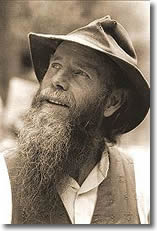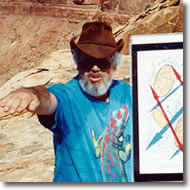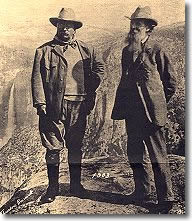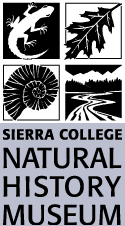Lectures 2005
February 25
Medicinal Plants of the Sierra Nevada
by Monique Kolster
What do yerba santa, cottonwood, silktassle, and manzanita have in common? These native California plants, while unrelated, fall into a single category when considered for human utilization—medicine! Join Mo Kolster for an interactive evening as she shares her knowledge and experience with a number of medicinal plants from the Sierra Nevada. Learn about some of the more often used and even the some obscure uses of our more common plants—first aid, cold and flu remedies, plant preparation and harvesting, and contraindications. Sample some tinctures, teas, and plants first hand!
After completing her Master’s Degree at the University of Montana, Missoula (where she worked with Echinacea) Mo continued her formal education in herbal medicine.
March 18
Plants in the Fossil Record: Links to the Past
by Walt Wright, Paleobotanist
Most of today’s plants bear little resemblance to those that emerged on land more than 450 million years ago. While they began earlier, the first fossil plants are found in the Silurian of the early-Paleozoic Era. From primitive moss-like plants evolved large ones like horsetails and ferns, and eventually cycads, ginkgos, and conifers in the Mesozoic.
Many of these larger plants were woody enough to leave fossils—the focus of this presentation. Using photographs and fossils from his extensive plant collections, paleobotanist Walt Wright will review the evolution of the plant kingdom, with a focus on the petrified wood of ancient trees. Wright is a biologist and geologist, an educator and naturalist, and a highly-regarded west-coast paleobotanist. This evening’s presentation will be followed by an extensive hands-on workshop (petrified wood identification), Saturday-Sunday, March 19-20.
April 22
John Muir in Among the Animals
Lee Stetson
 The icy storm story of a little dog named Stickeen is perhaps the most popular and most loved of John Muir's many adventures. This "funny, black, short-legged, bunchy-bodied, toy-dog", as he described Stickeen, gave Muir valuable insights into our kinship with all of the creatures humans share this good planet with—our "fellow mortals."
The icy storm story of a little dog named Stickeen is perhaps the most popular and most loved of John Muir's many adventures. This "funny, black, short-legged, bunchy-bodied, toy-dog", as he described Stickeen, gave Muir valuable insights into our kinship with all of the creatures humans share this good planet with—our "fellow mortals."
Among other stories in this amazing collection of animal tales, Muir chases a Yosemite bear, confronts coiled rattlesnakes, mourns the loss of the passenger pigeon, and tells of his hilarious encounters with sheep in the Yosemite high country.
May 6
Nature Noir
by Jordan Fisher Smith
Jordan Fisher Smith is the author of what the New York Times calls, "the eloquently meditative Nature Noir: A Park Ranger's Patrol in the Sierra. The Times' review goes on to say, "Smith relishes the physical detail, whether the subject is geology (the canyon chosen for the dam site was ''a Frankenstein's monster assembled out of bits of older stuff grave-robbed from dead landscapes elsewhere and sutured together at ragged, partially healed scars''), a cloud of migrating ladybugs, the unrelenting dust, or the little napkins that his fellow rangers place on their hoods to hold their doughnuts. His voice gains authority through its cadence and understatement."
Visit the book's website, www.naturenoir.com
May 8
Dinosaur Day
Lots of activities including a BBQ, cast painting, coloring, color sidewalk drawings, cookie painting, dinostore, face painting, fossil exploration sand box, fossil casting, and much more.
September 23
Climate Crash: Abrupt Climate Change and What it Means for Our Future
by John D. Cox
It is now apparent that alterations in Earth’s climate can happen quickly and dramatically. Evidence reveals that centuries of slow, creeping climate variations have actually been punctuated by far more rapid changes. Many researchers are now quietly abandoning the traditional vision of a long, slow waltz of slumbering ice ages and more temperate periods of interglacial warming. Instead, a drastic climate shift more sudden and troublesome than we’d ever imagined could already be underway.
What are the mechanisms for triggering a significant climate change? In what ways should we expect this change to manifest itself? When will it likely happen? Climate Crash seeks to answer these questions, breaking the story of rapid climate change to a general public that is already intensely curious about what science has to say on the topic.
John D. Cox is a science writer who worked at The Bee for twenty years. Prior to writing Climate Crash Mr. Cox also wrote Weather for Dummies (2000) and Storm Watchers: The Turbulent History of Weather Prediction from Franklin’s Kite to El Nino (2002).
October 21
Micropaleontology: The Coolest Fossils You’ve Never Seen!
By Laird Thompson
 It’s a rarity to find dinosaur fossils; they occur only in very specialized deposits and their preservation is rare (when a lion dies in the Serengeti, it will most likely never be preserved in the rock record). There are, however, untold billions of fossils in the Central Valley of California (and all over the planet)—they’re just very, very tiny! They are easily found, even in the tiny rock chips found on drill bits used while searching for oil.
It’s a rarity to find dinosaur fossils; they occur only in very specialized deposits and their preservation is rare (when a lion dies in the Serengeti, it will most likely never be preserved in the rock record). There are, however, untold billions of fossils in the Central Valley of California (and all over the planet)—they’re just very, very tiny! They are easily found, even in the tiny rock chips found on drill bits used while searching for oil.
Microfossils run the gamut from algae to animals—“weeds and seeds”—bits of oceanic plankton, tiny arthropods, and even some unknown creatures! Their shells of calcite or silica preserve their structure and their placement in the sediments tell us about when they lived as well as the climate of the time. The world of microfossils is rich and varied.
Dr. Thompson will introduce the museum audience, with spectacular illustrations, to the fascinating subject of micropaleontology and the tiny fossils that describe the life and times of the distant past.
November 10
The Tramp and the Roughrider: John Muir and Teddy Roosevelt
By Lee Stetson and Alan Sutterfield
 In May of 1903 President Theodore Roosevelt invited naturalist John Muir to join him on a four-day camping trip in the Yosemite wilderness. The Tramp and the Roughrider illuminates this extraordinary encounter, with the action unfolding at sunset on Glacier Point, overlooking magnificent Yosemite Valley. Both characters were feisty and opinionated. The had sharp disagreements on issues like hunting, animal rights and forest management. Muir’s poetic and evangelistic temperament, clashing with Roosevelt’s political and boyish enthusiasms, naturally spawned both tension and humor.
In May of 1903 President Theodore Roosevelt invited naturalist John Muir to join him on a four-day camping trip in the Yosemite wilderness. The Tramp and the Roughrider illuminates this extraordinary encounter, with the action unfolding at sunset on Glacier Point, overlooking magnificent Yosemite Valley. Both characters were feisty and opinionated. The had sharp disagreements on issues like hunting, animal rights and forest management. Muir’s poetic and evangelistic temperament, clashing with Roosevelt’s political and boyish enthusiasms, naturally spawned both tension and humor.
Both skillful storytellers, it seems natural that both would seek to top one another by relating some of their many adventures in the American wilderness—Roosevelt bring a frontier ruffian to justice, for example, or Muir telling of his hair-raising “interview” with a Yosemite bear. At the time of this historic meeting, many millions of acres of our western forests, with little or no governmental supervision, were being exploited and abused by hunting, lumbering, grazing, and mining interests. But around the campfire, sifting through their histories and their hopes, these very different men slowly discovered how the other had been shaped by the wilderness they both loved—opening up some rich possibilities for “doing some forest good.”
Join professional actors Lee Stetson and Alan Butterfield for this rare performance, commemorating this historically significant event in American history.
December 15
Life in the Food Chain: The Biology of Sharks, Seals, and Surfers
By John McCosker, Director, Steinhart Aquarium
White sharks, the largest flesh-eating fish on the planet, are variously feared, revered, and protected along the California coastline. They are responsible for nearly all shark attacks upon humans in California, yet recent studies of their biology and behavior is such that attacks upon humans can be significantly reduced. Their role as a top level predator along our coastline is now better understood, and despite the risk to our species, their species is protected. So, 30 years after the film Jaws, people are becoming aware that love 'em or fear 'em, humans in California are better off with live rather than dead Carcharodon carcharias.
Mark you calendars for a spectacular illustrated presentation by California Academy’s Steinhart Aquarium Director, Dr. John McCosker. Learn all about sharks, shark attacks, Great White Shark biology and ecology, and the status of sharks (endangered species, shark slaughter for fins), and the future of these incredible creatures in our world.
November 11-13 and November 18-20
Aquatic Insect Monitoring
Three-day workshops
So what is a hellgrammite? A stonefly? A caddis fly? What kinds of fish swim in our streams and creeks? Are our watersheds being polluted? Protected?
Join Dry Creek Conservancy staff and California Department of Fish and Game environmental scientist Jim Harrington for a three-day workshop about the fascinating world of aquatic ecosystems and how to understand and protect them.
Co-sponsored by a Clean Water Act grant from the State Department of Water Resources, this exciting workshop includes both in-laboratory and outdoors hands-on introductions in stream ecology and stream assessment procedures.
Encouraging citizen knowledge and awareness of community natural resources, this is a way for us to become involved in efforts to preserve important natural communities.
This workshop includes classroom presentations, discussions, demonstrations and in-the-field techniques for collecting, identifying, and evaluating local steams for quality and protection.
 The icy storm story of a little dog named Stickeen is perhaps the most popular and most loved of John Muir's many adventures. This "funny, black, short-legged, bunchy-bodied, toy-dog", as he described Stickeen, gave Muir valuable insights into our kinship with all of the creatures humans share this good planet with—our "fellow mortals."
The icy storm story of a little dog named Stickeen is perhaps the most popular and most loved of John Muir's many adventures. This "funny, black, short-legged, bunchy-bodied, toy-dog", as he described Stickeen, gave Muir valuable insights into our kinship with all of the creatures humans share this good planet with—our "fellow mortals." 
 It’s a rarity to find dinosaur fossils; they occur only in very specialized deposits and their preservation is rare (when a lion dies in the Serengeti, it will most likely never be preserved in the rock record). There are, however, untold billions of fossils in the Central Valley of California (and all over the planet)—they’re just very, very tiny! They are easily found, even in the tiny rock chips found on drill bits used while searching for oil.
It’s a rarity to find dinosaur fossils; they occur only in very specialized deposits and their preservation is rare (when a lion dies in the Serengeti, it will most likely never be preserved in the rock record). There are, however, untold billions of fossils in the Central Valley of California (and all over the planet)—they’re just very, very tiny! They are easily found, even in the tiny rock chips found on drill bits used while searching for oil.  In May of 1903 President Theodore Roosevelt invited naturalist John Muir to join him on a four-day camping trip in the Yosemite wilderness. The Tramp and the Roughrider illuminates this extraordinary encounter, with the action unfolding at sunset on Glacier Point, overlooking magnificent Yosemite Valley. Both characters were feisty and opinionated. The had sharp disagreements on issues like hunting, animal rights and forest management. Muir’s poetic and evangelistic temperament, clashing with Roosevelt’s political and boyish enthusiasms, naturally spawned both tension and humor.
In May of 1903 President Theodore Roosevelt invited naturalist John Muir to join him on a four-day camping trip in the Yosemite wilderness. The Tramp and the Roughrider illuminates this extraordinary encounter, with the action unfolding at sunset on Glacier Point, overlooking magnificent Yosemite Valley. Both characters were feisty and opinionated. The had sharp disagreements on issues like hunting, animal rights and forest management. Muir’s poetic and evangelistic temperament, clashing with Roosevelt’s political and boyish enthusiasms, naturally spawned both tension and humor.